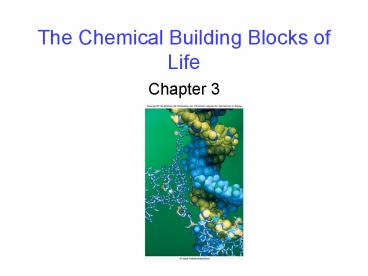The Chemical Building Blocks of Life PowerPoint PPT Presentation
1 / 49
Title: The Chemical Building Blocks of Life
1
The Chemical Building Blocks of Life
- Chapter 3
2
Biological Molecules
- Biological molecules consist primarily of
- -carbon bonded to carbon, or
- -carbon bonded to other molecules.
- Carbon can form up to 4 covalent bonds.
- Carbon may be bonded to functional groups with
specific properties.
3
(No Transcript)
4
Biological Molecules
- Isomers are molecules with the same chemical
formula. - -structural isomers
- -stereoisomers
- Chiral molecules are mirror-images of each other.
5
Biological Molecules
6
Biological Molecules
- Biological molecules are typically large
molecules constructed from smaller subunits. - Monomer single subunit
- (mono 1 -mer unit)
- Polymer many units
- (poly many)
7
Biological Molecules
- dehydration synthesis formation of large
molecules by the removal of water - -monomers are joined to form polymers
- hydrolysis breakdown of large molecules by the
addition of water - -polymers are broken down to monomers
8
Biological Molecules
9
Carbohydrates
- Molecules with a 121 ratio of carbon, hydrogen,
oxygen - -empirical formula (CH2O)n
- -examples sugars, starch, glucose
- C H covalent bonds hold much energy
- Carbohydrates are good energy storage molecules.
10
Carbohydrates
- Glucose
- -a monosaccharide single sugar
- -contains 6 carbons
- -very important in energy storage
- -fructose is a structural isomer of glucose
- -galactose is a stereoisomer of glucose
11
Carbohydrates
12
Carbohydrates
13
Carbohydrates
- Disaccharides
- -2 monosaccharides linked together by
dehydration synthesis - -used for sugar transport or energy storage
- -examples sucrose, lactose, maltose
14
Carbohydrates
15
Carbohydrates
- Polysaccharides
- -long chains of sugars
- -used for energy storage
- -plants use starch animals use glycogen
- -used for structural support
- -plants use cellulose animals use chitin
16
Carbohydrates
17
Carbohydrates
18
Carbohydrates
19
Nucleic Acids
- Two types DNA and RNA
- Functions specialized for the storage,
transmission, and use of genetic information
20
Nucleic Acids
- Nucleic acids are polymers of nucleotides.
- -nucleotides
- sugar phosphate nitrogenous base
- -sugar is deoxyribose in DNA
- or ribose in RNA
- -Nitrogenous bases include
- -purines adenine and guanine
- -pyrimidines thymine, cytosine, uracil
21
Nucleic Acids
22
Nucleic Acids
23
Nucleic Acids
- DNA
- -nucleotides connected by phosphodiester bonds
- - double helix 2 polynucleotide strands
connected by hydrogen bonds - -polynucleotide strands are complementary
- -genetic information is carried in the sequence
of nucleotides
24
Nucleic Acids
25
Nucleic Acids
- RNA
- -contains ribose instead of deoxyribose
- -contains uracil instead of thymine
- -single polynucleotide strand
- -functions
- -read the genetic information in DNA
- -direct the synthesis of proteins
26
Nucleic Acids
27
Nucleic Acids
- Other nucleotides
- -ATP adenosine triphosphate
- -primary energy currency of the cell
- -NAD and FAD electron carriers for many
cellular reactions
28
Proteins
- Protein functions include
- 1. enzyme catalysts
- 2. defense
- 3. transport
- 4. support
- 5. motion
- 6. regulation
- 7. storage
29
Proteins
- Proteins are polymers of amino acids.
- Amino acids
- -20 different amino acids
- -joined by dehydration synthesis
- -peptide bonds form between adjacent amino acids
30
Proteins
31
Proteins
- Amino acid structure
- -central carbon atom surrounded by
- -amino group
- -carboxyl group
- -single hydrogen
- -variable R group
32
Proteins
- The structure of the R group dictates the
chemical properties of the amino acid. - Amino acids can be classified as
- 1. nonpolar
- 2. polar
- 3. charged
- 4. aromatic
- 5. special function
33
Proteins
- The shape of a protein determines its function.
- -primary structure sequence of amino acids
- -secondary structure interaction of groups in
the peptide backbone - -a helix
- -b sheet
34
Proteins
35
Proteins
- Protein structure (continued)
- -tertiary structure folded shape of the
polypeptide chain - -quaternary structure interactions between
multiple polypeptide subunits - Protein folding is aided by chaperone proteins.
36
Proteins
37
Proteins
- Motifs are common elements of secondary structure
seen in many polypeptides. - Domains are functional regions of a polypeptide.
38
Proteins
39
Proteins
- Denaturation is a change in the shape of a
protein, usually causing loss of function. - -may involve complete unfolding
- -caused by changes in the proteins environment
- -pH
- -temperature
- -salt concentration
40
Proteins
41
Lipids
- Lipids are a group of molecules that are
insoluble in water. - A high proportion of nonpolar C H bonds causes
the molecule to be hydrophobic. - Two main categories
- -fats (triglycerides)
- -phospholipids
42
Lipids
- Triglycerides (fats)
- -composed of 1 glycerol 3 fatty acids
- Fatty acids are long hydrocarbon chains which may
be - -saturated
- -unsaturated
- -polyunsaturated
43
Lipids
44
Lipids
45
Lipids
- Triglycerides
- -an excellent molecule for energy storage
- -store twice as much energy as carbohydrates
- -animal fats are usually saturated fats and are
solid at room temperature - -plant fats (oils) are usually unsaturated and
are liquid at room temperature
46
Lipids
- Phospholipids -composed of
- -1 glycerol
- -2 fatty acids
- -a phosphate group
- Phospholipids contain polar heads and nonpolar
tails.
47
Lipids
48
Lipids
- Phospholipids spontaneously form micelles or
lipid bilayers. - These structures cluster the hydrophobic regions
of the phospholipid toward the inside and leave
the hydrophilic regions exposed to the water
environment. - Lipid bilayers are the basis of biological
membranes.
49
Lipids

